| |

 |
|


27 Years
on the Web!
|

Silent War
by Neal Stevens, Valerie Stevens,
Vickie Stevens
July 22, 2006

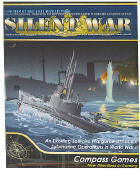 Before
there were subsim computer games naval enthusiasts enacted their sea battles
on board games. At the turn
of the 20th century H.G. Wells and Jane's Fighting Ships developed rules for
games with miniatures. Soon mainstream game companies such as Milton Bradley
(Battleship), Avalon Hill (U-Boat, Submarine), S&T (Wolfpack), and others
followed. When I was a kid, I even created my
own submarine
board game to recreate the experience of stalking the enemy convoys in
the open oceans. Since the personal computer became as common as the
toothbrush, board games have diminished in favor of computer simulations that
handle all the calculations for rule and record keeping as well as display 3D
graphics and sounds equal to any movie. Where a computer sim manages this
behind the scenes and presents the player with the continuously updated
tactical situation, a board game requires the player to track all these
elements. The more in-depth the game, the more labor-intensive the game
becomes. For players who are used to a few mouse clicks to sink a ship, a
board game can be daunting. Yet despite the numerous tasks involved in
playing a board game there remains a sizeable group of fans. For them, Compass Games offers Silent War, a
highly detailed US Pacific WWII submarine game. Before
there were subsim computer games naval enthusiasts enacted their sea battles
on board games. At the turn
of the 20th century H.G. Wells and Jane's Fighting Ships developed rules for
games with miniatures. Soon mainstream game companies such as Milton Bradley
(Battleship), Avalon Hill (U-Boat, Submarine), S&T (Wolfpack), and others
followed. When I was a kid, I even created my
own submarine
board game to recreate the experience of stalking the enemy convoys in
the open oceans. Since the personal computer became as common as the
toothbrush, board games have diminished in favor of computer simulations that
handle all the calculations for rule and record keeping as well as display 3D
graphics and sounds equal to any movie. Where a computer sim manages this
behind the scenes and presents the player with the continuously updated
tactical situation, a board game requires the player to track all these
elements. The more in-depth the game, the more labor-intensive the game
becomes. For players who are used to a few mouse clicks to sink a ship, a
board game can be daunting. Yet despite the numerous tasks involved in
playing a board game there remains a sizeable group of fans. For them, Compass Games offers Silent War, a
highly detailed US Pacific WWII submarine game.
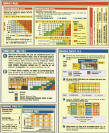 To
call Silent War a game is akin to calling the priesthood a hobby. Prepare to
undergo some serious indoctrination--this game really tries to replicate
every aspect of the entire war. Silent War is described as a "solitaire
simulation of the United States' submarine war against Imperial Japan"
during WWII. Don't be misled by the term "solitaire", the game is more fun
when played with a friend or in a small group and there are provisions for
co-op play, you just can't play head-to-head against another player. The game comes packaged in a nice, illustrated box. Inside there
are several sheets of small die-cut tiles, a few glossy rules and guidelines
sheets, dice, and a large, vividly-illustrated game map of the Pacific
Theater. My playing assistants and I were mightily impressed with the
production values of the materials. The printing and layout are
well-designed and of high quality. To
call Silent War a game is akin to calling the priesthood a hobby. Prepare to
undergo some serious indoctrination--this game really tries to replicate
every aspect of the entire war. Silent War is described as a "solitaire
simulation of the United States' submarine war against Imperial Japan"
during WWII. Don't be misled by the term "solitaire", the game is more fun
when played with a friend or in a small group and there are provisions for
co-op play, you just can't play head-to-head against another player. The game comes packaged in a nice, illustrated box. Inside there
are several sheets of small die-cut tiles, a few glossy rules and guidelines
sheets, dice, and a large, vividly-illustrated game map of the Pacific
Theater. My playing assistants and I were mightily impressed with the
production values of the materials. The printing and layout are
well-designed and of high quality.
|
Exam question 1: When playing board games, you must remember: |
|
a. There are no CDs included, don't fire off any angry e-mails to the
game dev complaining yours is missing. |
|
b. The cat can alter the whole complexion of the war by jumping on
the table. |
|
c. Losing sub tiles will weaken your war effort. |
|
d. All of the above |
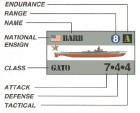 The
game allows you to play a scenario, a stage of the war, or the whole
campaign. First, you get the to punch out all the die-cut tiles. Each tile
represents a submarine that the US fielded in the war with that sub's
speed, endurance, attack, and defense ratings, year entered into the war and name. My first gripe: There are over 360 of them and each sub is
specifically named; there's a tile for the USS Albacore, a tile for the USS
Tang, the USS Cavalla, the Silverfish, etc...so keeping them in some sort
of order is a burdensome task. Alas, in order to give the player the full
roster of subs to manage at any one time in the war, I suppose there was no
way around it. And all this time I thought an Admiral's job was cushy. The
game allows you to play a scenario, a stage of the war, or the whole
campaign. First, you get the to punch out all the die-cut tiles. Each tile
represents a submarine that the US fielded in the war with that sub's
speed, endurance, attack, and defense ratings, year entered into the war and name. My first gripe: There are over 360 of them and each sub is
specifically named; there's a tile for the USS Albacore, a tile for the USS
Tang, the USS Cavalla, the Silverfish, etc...so keeping them in some sort
of order is a burdensome task. Alas, in order to give the player the full
roster of subs to manage at any one time in the war, I suppose there was no
way around it. And all this time I thought an Admiral's job was cushy.
|
Exam question 2: One thing a board game
teaches you is: |
|
a. To stack little tiles in meticulous order of "date entered in
war". |
|
b. The US had too many subs |
|
c. Who knew there were so many kinds of different fish? |
|
d. All of the above |

There are also tiles for the Japanese ships and
thankfully, these are somewhat generic, categorized by their attributes and
a handful of major warships listed by name. The Japanese marus and escorts
are split into four historically accurate war periods and kept in four
cups supplied by the player. This is called the "War Mix".
When one of your subs makes contact and an engagement begins, you pull some
ships from the correct cup and lay them out on the combat display sheet. Be
careful not to pour coffee into a War Mix
cup after long hours of play, nothing disrupts a war like choking on
caffeinated marus. Other tiles denote date markers, tonnage markers,
Ultra Areas, and functions used with tracking damage and TDC utility.
|
Exam question 3: To be successful playing
Silent War, one must |
|
a. Have the patience of Job |
|
b. Have a Mensa-level IQ |
|
c. Really love and enjoy naval board games |
|
d. All of the above |
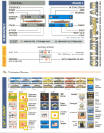 Once
you have the tiles punched out, organized, and the map spread, it's that
moment that will make you or break you as a Silent War board game
player--cracking open the rules book. My advise: relax and enjoy the
learning process. The developers of Silent War suggest starting off with a
simple scenario and working through the rule book, learning as you play.
Excellent advice! You will quickly see that Silent War is played in Game
Turns, each turn representing a week of actual war time. In each Game Turn
is a Segment, and each Segment consists of Phases, like nested
Matryoshka dolls. You play
through each phase completing tasks by rolling the dice, updating counters,
moving to patrol areas, completing repairs, and when opportunity allows,
conducting attacks. Once
you have the tiles punched out, organized, and the map spread, it's that
moment that will make you or break you as a Silent War board game
player--cracking open the rules book. My advise: relax and enjoy the
learning process. The developers of Silent War suggest starting off with a
simple scenario and working through the rule book, learning as you play.
Excellent advice! You will quickly see that Silent War is played in Game
Turns, each turn representing a week of actual war time. In each Game Turn
is a Segment, and each Segment consists of Phases, like nested
Matryoshka dolls. You play
through each phase completing tasks by rolling the dice, updating counters,
moving to patrol areas, completing repairs, and when opportunity allows,
conducting attacks.
The Operations Segment is conducted
individually for each sub, so depending on the time of the war and
number of subs on patrol, you can spend several hours going through the
fleet. When one of your subs engages the enemy, you have another set of
rules for the Combat Phase. Gripe #2: there is a lot of manual math involved
in calculating the Tactical Rating of the subs, the TDC values, torpedo
values, and target defense values. I understand that these elements have to
be taken into consideration but I think it should have been simplified. You
have to determine all the ratings of your sub, add in any extra for having a
"super skipper" (really good captain), determine the ratings for the target
ships you oppose, and factor in the TDC values to get your "attack points
assigned". Then...
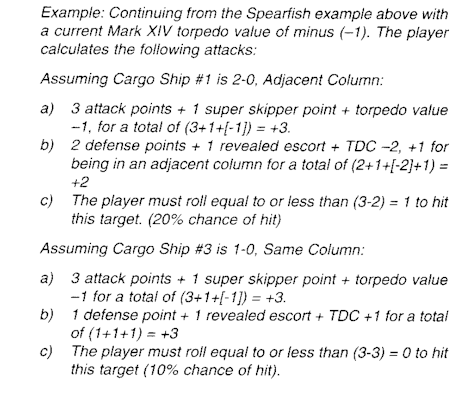
Yeah, you get the picture? It's a
handful. Necessary to develop a complete tactical event, perhaps, but not
conducive to brisk and lively gameplay.
|
Exam question 4: After assigning 4 attack
points to Cargo Ship #1 and 1 attack point to Cargo Ship #3... |
|
a. You wonder what happened to Cargo Ship #2 |
|
b. You roll the dice and considering your luck, be grateful you're
not in Vegas |
|
c. Turn the forums over to Gizzmoe and head to Vegas |
|
d. All of the above |
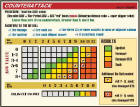 You use certain markers to track the
progress of each round of attack, counterattack, withdrawal, and "re-attack"
rounds. There are provisions for aircraft attacks, surface gun attacks,
circular running torpedoes, special missions, Ultra intercepts, Wolfpacks...
just about any situation you can imagine that is historically based. The map
contains many of the basic charts and tables. Additionally there are several
colorful 8 1/2 x 11-inch charts that allow you to play without digging
through the rules book, once you get familiar with the process. You use certain markers to track the
progress of each round of attack, counterattack, withdrawal, and "re-attack"
rounds. There are provisions for aircraft attacks, surface gun attacks,
circular running torpedoes, special missions, Ultra intercepts, Wolfpacks...
just about any situation you can imagine that is historically based. The map
contains many of the basic charts and tables. Additionally there are several
colorful 8 1/2 x 11-inch charts that allow you to play without digging
through the rules book, once you get familiar with the process.
With a game this complex and
protracted, it helps to have a friend playing alongside. This is truly a
boon for understanding the rules in the beginning, too. I drafted my
daughter Valerie, an honors student, to assist me in interpreting the rules
and game procedures. We would discuss the various parts of the game and
debate what some of the sections meant. Silent War has a steep learning
curve, you can master it quicker with help. It's more fun that way, too.
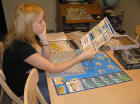
Getting started |
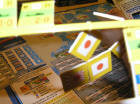
Gasp! Hanging chads! |
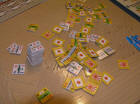
The Imperial Japanese Fleet |
| |
|
|
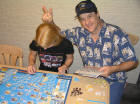
Exploiting the hired help |
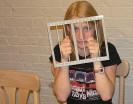
So many rules! |
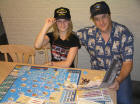
Valerie, Neal Stevens |
| |
|
|
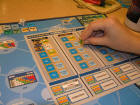
Setting up an attack on a convoy |
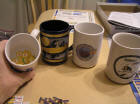
"War Mix" is not something you can dance to |
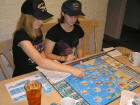
What do you mean, my torpedo missed? |
Many of the rules and values take
into account factors such as the US torpedo scandal. The game values
torpedoes in the latter stages of the war as 200% improved over the
torpedoes US skippers were stuck with at the onset of the conflict. The game
also includes the aggressive Dutch submarines who fought alongside the
British and US boats, crediting Drebbel's
www.dutchsubmarines.com for
assistance.
|
Exam question 5: When your playing assistants
complain that the game is too hard, you respond by: |
|
a. Patiently reminding them that this is how their ancestors
recreated the Battle of Coral Sea |
|
b. Casually kick them under the table pointing out you
are not an ancestor |
|
c. Whine that it's too hard for you, too! |
|
d. None of the above |
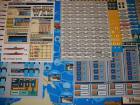 There is, as previously stated, the
main campaign that encompasses the entire war, and five other
campaigns that are broken down into major eras of the war. The game is
designed to take a long, long time to complete. Just completing the moves
through one turn for one sub that makes contact and brings into play the
combat phase can consume an hour. It's imperative to have a good, secure
place to set up the game where the pieces will not be disturbed in order to
leave and resume. I also recommend keeping a notebook, a "Captain's Log"
where you can keep track of the subs and which one has been played, so that
when you return to the game after a day or two, you aren't totally lost. There is, as previously stated, the
main campaign that encompasses the entire war, and five other
campaigns that are broken down into major eras of the war. The game is
designed to take a long, long time to complete. Just completing the moves
through one turn for one sub that makes contact and brings into play the
combat phase can consume an hour. It's imperative to have a good, secure
place to set up the game where the pieces will not be disturbed in order to
leave and resume. I also recommend keeping a notebook, a "Captain's Log"
where you can keep track of the subs and which one has been played, so that
when you return to the game after a day or two, you aren't totally lost.
For shorter games, you have can
choose from nine Patrol Games, where you manage just one submarine on one
patrol. This is the suggested beginner's route for learning the mechanics of
the game and working through all the phases and turns.
I tip my hat to
Compass Games, they
seem to have achieved something unique. They incorporated vast amounts of data in order to give the
player a thorough and balanced account of the war. It's obvious a huge
amount of time, work, thought, and testing went into this. Playing the game
will allow you to learn more about the US submarine war than many books. I
will repeat the warning provided by the game developer in the Scenario Book;
this is not for people with a deficit of patience and desire and short
attention spans. Silent War is not a quick, nor easy, pastime. But for the
truest devotees of the US Submarine war in the Pacific, Silent War is the
most complete submarine board game on the market.
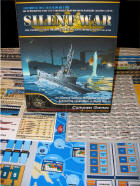 Designer:
Brien Miller Designer:
Brien Miller
Publisher:
Compass Games, LLC
Answers to the Silent War Exam
1. d, 2. d, 3. c, 4. c, 5. d
|

SUBSIM® Review
© 1995-2024 SUBSIM® Review
"Subsim" is a registered trademark. All rights reserved.
Legal Notice
| Privacy
Policy
submarine, game, submarine game, wolfpack, u-boat, simulation, subsim, sim
| |

